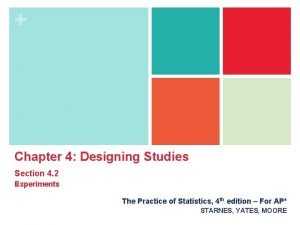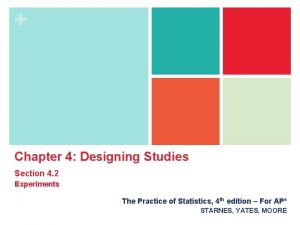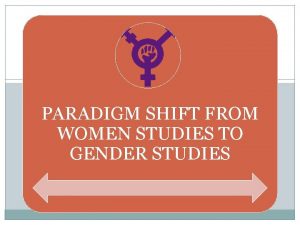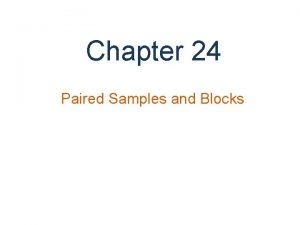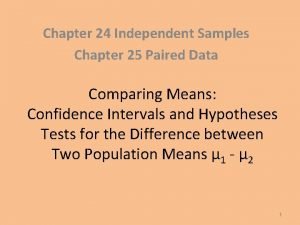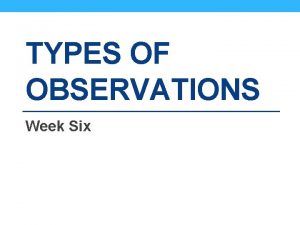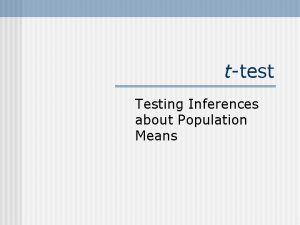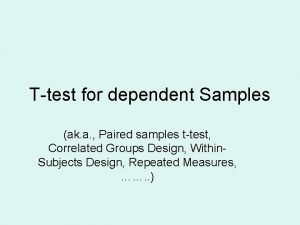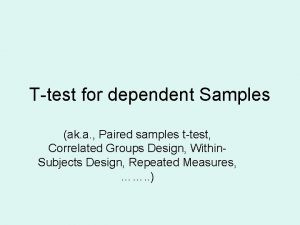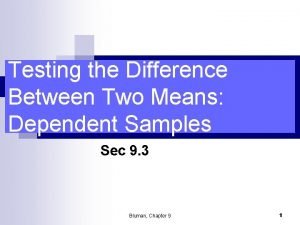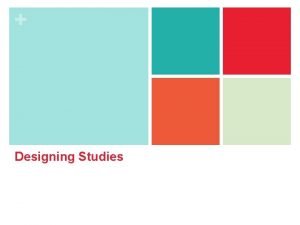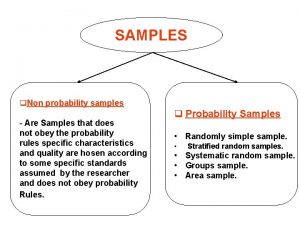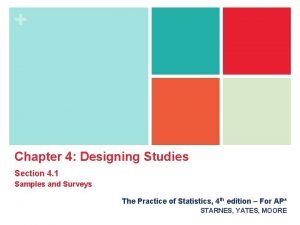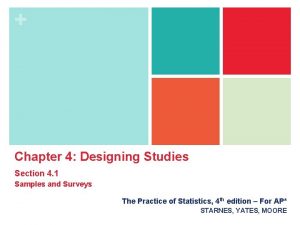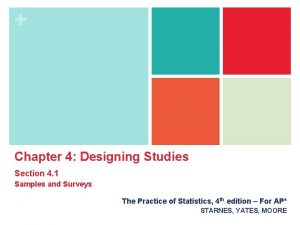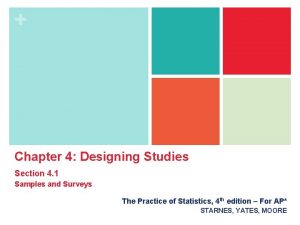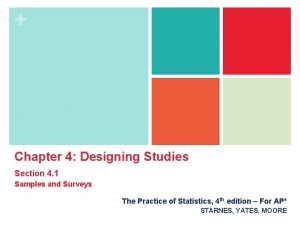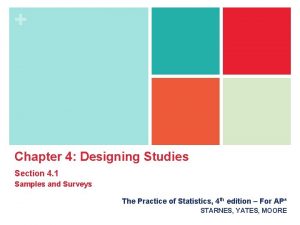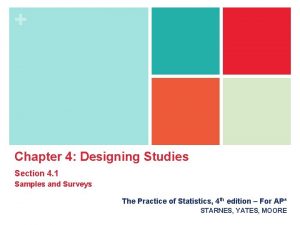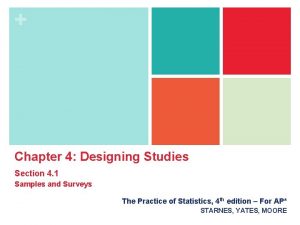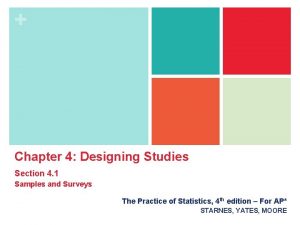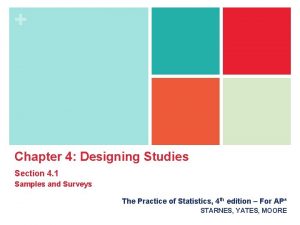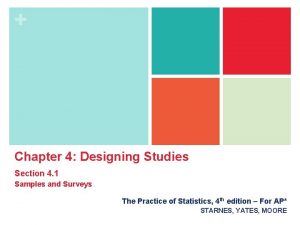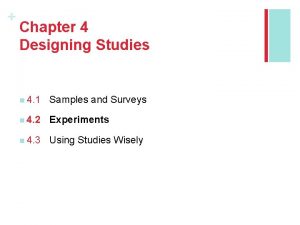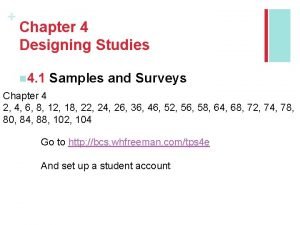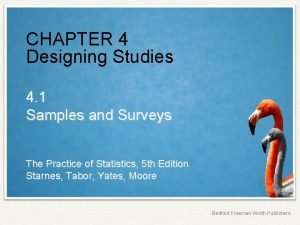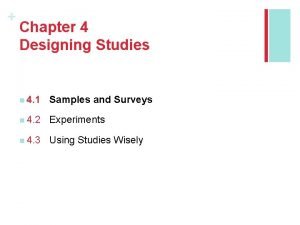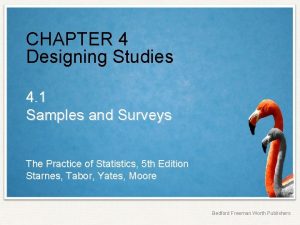Chapter 4 Designing Studies Section 4 1 Samples



















- Slides: 19

+ Chapter 4: Designing Studies Section 4. 1 Samples and Surveys The Practice of Statistics, 4 th edition – For AP* STARNES, YATES, MOORE

+ Chapter 4 Designing Studies n 4. 1 Samples and Surveys n 4. 2 Experiments n 4. 3 Using Studies Wisely

+ Section 4. 1 Samples and Surveys Learning Objectives After this section, you should be able to… ü IDENTIFY the population and sample in a sample survey ü IDENTIFY voluntary response samples and convenience samples ü DESCRIBE how to use a table of random digits to select a simple random sample (SRS) ü DESCRIBE simple random samples, stratified random samples, and cluster samples ü EXPLAIN how undercoverage, nonresponse, and question wording can lead to bias in a sample survey

and Sample + n Population Definition: The population in a statistical study is the entire group of individuals about which we want information. A sample is the part of the population from which we actually collect information. We use information from a sample to draw conclusions about the entire population. Population Sampling and Surveys The distinction between population and sample is basic to statistics. To make sense of any sample result, you must know what population the sample represents Collect data from a representative Sample. . . Sample Make an Inference about the Population.

Idea of a Sample Survey Choosing a sample from a large, varied population is not that easy. Step 1: Define the population we want to describe. Step 2: Say exactly what we want to measure. A “sample survey” is a study that uses an organized plan to choose a sample that represents some specific population. Step 3: Decide how to choose a sample from the population. Sampling and Surveys We often draw conclusions about a whole population on the basis of a sample. + n The

to Sample Badly Definition: Choosing individuals who are easiest to reach results in a convenience sample. Convenience samples often produce unrepresentative data…why? Definition: The design of a statistical study shows bias if it systematically favors certain outcomes. Sampling and Surveys How can we choose a sample that we can trust to represent the population? There a number of different methods to select samples. + n How

to Sample Badly samples are almost guaranteed to show bias. So are voluntary response samples, in which people decide whether to join the sample in response to an open invitation. Definition: A voluntary response sample consists of people who choose themselves by responding to a general appeal. Voluntary response samples show bias because people with strong opinions (often in the same direction) are most likely to respond. Sampling and Surveys n Convenience + n How

to Sample Well: Random Sampling The statistician’s remedy is to allow impersonal chance to choose the sample. A sample chosen by chance rules out both favoritism by the sampler and self-selection by respondents. n Random sampling, the use of chance to select a sample, is the central principle of statistical sampling. Definition: A simple random sample (SRS) of size n consists of n individuals from the population chosen in such a way that every set of n individuals has an equal chance to be the sample actually selected. In practice, people use random numbers generated by a computer or calculator to choose samples. If you don’t have technology handy, you can use a table of random digits. Sampling and Surveys n + n How

to Choose an SRS Sampling and Surveys Definition: A table of random digits is a long string of the digits 0, 1, 2, 3, 4, 5, 6, 7, 8, 9 with these properties: • Each entry in the table is equally likely to be any of the 10 digits 0 - 9. • The entries are independent of each other. That is, knowledge of one part of the table gives no information about any other part. + n How to Choose an SRS Using Table D Step 1: Label. Give each member of the population a numerical label of the same length. Step 2: Table. Read consecutive groups of digits of the appropriate length from Table D. Your sample contains the individuals whose labels you find.

Problem: Use Table D at line 130 to choose an SRS of 4 hotels. 01 Aloha Kai 02 Anchor Down 03 Banana Bay 04 Banyan Tree 05 Beach Castle 06 Best Western 07 Cabana 69051 08 Captiva 09 Casa del Mar 10 Coconuts 11 Diplomat 12 Holiday Inn 13 Lime Tree 14 Outrigger 15 Palm Tree 16 Radisson 17 Ramada 18 Sandpiper 19 Sea Castle 20 Sea Club 21 Sea Grape 22 Sea Shell 23 Silver Beach 24 Sunset Beach 25 Tradewinds 26 Tropical Breeze 27 Tropical Shores 28 Veranda 64817 87174 09517 84534 06489 87201 97245 Sampling and Surveys n How to Choose an SRS + n Example: 69 05 16 48 17 87 17 40 95 17 84 53 40 64 89 87 20 Our SRS of 4 hotels for the editors to contact is: 05 Beach Castle, 16 Radisson, 17 Ramada, and 20 Sea Club.

Sampling Methods The basic idea of sampling is straightforward: take an SRS from the population and use your sample results to gain information about the population. Sometimes there are statistical advantages to using more complex sampling methods. n One common alternative to an SRS involves sampling important groups (called strata) within the population separately. These “sub-samples” are combined to form one stratified random sample. Definition: To select a stratified random sample, first classify the population into groups of similar individuals, called strata. Then choose a separate SRS in each stratum and combine these SRSs to form the full sample. Sampling and Surveys n + n Other

Sampling Methods a stratified random sample can sometimes give more precise information about a population than an SRS, both sampling methods are hard to use when populations are large and spread out over a wide area. n In that situation, we’d prefer a method that selects groups of individuals that are “near” one another. Definition: To take a cluster sample, first divide the population into smaller groups. Ideally, these clusters should mirror the characteristics of the population. Then choose an SRS of the clusters. All individuals in the chosen clusters are included in the sample. Sampling and Surveys n Although + n Other

Sampling at a School Assembly Describe how you would use the following sampling methods to select 80 students to complete a survey. n (a) Simple Random Sample n (b) Stratified Random Sample n (c) Cluster Sample Sampling and Surveys n + n Example:

for Sampling The purpose of a sample is to give us information about a larger population. n The process of drawing conclusions about a population on the basis of sample data is called inference. Why should we rely on random sampling? 1)To eliminate bias in selecting samples from the list of available individuals. 2)The laws of probability allow trustworthy inference about the population • Results from random samples come with a margin of error that sets bounds on the size of the likely error. • Larger random samples give better information about the population than smaller samples. Sampling and Surveys n + n Inference

Surveys: What Can Go Wrong? Most sample surveys are affected by errors in addition to sampling variability. n Good sampling technique includes the art of reducing all sources of error. Definition Undercoverage occurs when some groups in the population are left out of the process of choosing the sample. Nonresponse occurs when an individual chosen for the sample can’t be contacted or refuses to participate. A systematic pattern of incorrect responses in a sample survey leads to response bias. The wording of questions is the most important influence on the answers given to a sample survey. Sampling and Surveys n + n Sample


+ Section 4. 1 Samples and Surveys Summary In this section, we learned that… ü A sample survey selects a sample from the population of all individuals about which we desire information. ü Random sampling uses chance to select a sample. ü The basic random sampling method is a simple random sample (SRS). ü To choose a stratified random sample, divide the population into strata, then choose a separate SRS from each stratum. ü To choose a cluster sample, divide the population into groups, or clusters. Randomly select some of the clusters for your sample.

+ Section 4. 1 Samples and Surveys Summary, con’t In this section, we learned that… ü Failure to use random sampling often results in bias, or systematic errors in the way the sample represents the population. ü Voluntary response samples and convenience samples are particularly prone to large bias. ü Sampling errors come from the act of choosing a sample. Random sampling error and undercoverage are common types of error. ü The most serious errors are nonsampling errors. Common types of sampling error include nonresponse, response bias, and wording of questions.

+ Looking Ahead… In the next Section… We’ll learn how to produce data by designing experiments. We’ll learn about ü Observational Studies vs. Experiments ü The Language of Experiments ü Randomized Comparative Experiments ü Principles of Experimental Design ü Inference for Experiments ü Blocking ü Matched Pairs Design
 Matched pair design
Matched pair design Chapter 4 designing studies
Chapter 4 designing studies Islamic studies lesson plan samples
Islamic studies lesson plan samples Paradigm shift from women studies to gender studies
Paradigm shift from women studies to gender studies Ap stats chapter 24 paired samples and blocks
Ap stats chapter 24 paired samples and blocks Chapter 24 paired samples and blocks
Chapter 24 paired samples and blocks Chapter 25 paired samples and blocks
Chapter 25 paired samples and blocks Chapter 10 section 1 meiosis answer key
Chapter 10 section 1 meiosis answer key Chapter 3 designing and planning
Chapter 3 designing and planning Designing and managing service processes
Designing and managing service processes Chapter 7 designing organizational structure
Chapter 7 designing organizational structure Chapter 7 designing organizational structure
Chapter 7 designing organizational structure Designing and managing services ppt
Designing and managing services ppt Paradigm of the channel design decision
Paradigm of the channel design decision Telpas samples
Telpas samples Cooking in the sandpit observation
Cooking in the sandpit observation Formula for t test independent samples
Formula for t test independent samples Dependent ttest
Dependent ttest Dependent t-test
Dependent t-test Testing the difference between two means dependent samples
Testing the difference between two means dependent samples
